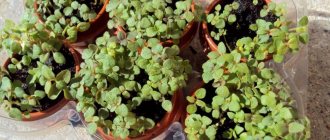Description of the plant and best views
Chlorophytum is a herbaceous plant from the Liliaceae genus. Species with narrow and wide leaves, as well as green and striped leaves are available for gardeners.
Chlorophytum is a lush bush. The leaves are collected in a bunch and fit tightly to each other. As the leaves grow, they droop and reach a length of 50 cm. Peduncles grow from the center of the bunch. The flowers are small and white. After flowering, young bushes with aerial roots form on the stems, which are used for propagation.
Advantages of growing chlorophytum:
- easy to care for;
- grows quickly;
- is highly decorative;
- Can be grown hydroponically (no soil).
The plant blooms from March to October. From October to January the rest period begins. Description of popular types in the table.
| View | Description |
| Crested | The leaves are long, hanging down, green in color with white longitudinal stripes. There are several varieties with a stripe down the center of the leaf and with white stripes along the edges. |
| Curly | The leaves do not droop, but curl. There is a wide white stripe in the center. The plant looks more compact. |
| Cape | It is distinguished by its large size. The leaves are green without white stripes, up to 3 cm wide, flower stalks are not formed on the arrows. |
| Winged | The leaves are dark green, wide, up to 30 cm long. They grow on pink petioles. Peduncles with fruits similar to ears of corn. |
Cape chlorophytum reproduces only by dividing the bush.
Crested chlorophytum is the most common among gardeners.
general description
Chlorophytum is one of the most unpretentious indoor plants.
Chlorophytum is a favorite indoor plant of those gardeners who like bright, lush greenery, but do not really like the daily painstaking work in the greenhouse. Also, this flower, or rather a bush, is suitable for those who are often away from home and do not find time for regular watering, loosening, fertilizing and replanting the plant.
Chlorophytum is ideal for offices, schools, kindergartens and medical institutions. It tolerates dry air, direct ultraviolet rays well, and is not afraid of infrequent watering and light frosts. The flower is not capricious and continues to turn cheerfully green even with minimal care. Typically, chlorophytum is grown in a hanging pot or on a stand so that its lush leaves fall freely. But this flower looks no less impressive in a flowerbed surrounded by other flowers and plants.
The houseplant tolerates almost all soils well and grows well in pots of any size. But experienced gardeners note that he especially likes hydroponics. Flowering of the plant begins in March and continues until the end of the growing season. The dormant period begins in October and lasts until January. The plant tolerates winter, low temperatures, as well as summer heat and drought. If a flower is not watered for a long time, the tips of its leaves will begin to dry, the plant will lose its splendor and bright color, but will not die.
For this endurance and unpretentiousness, the flower is loved by novice gardeners. But this is not his only advantage. Chlorophytum is able to effectively purify and humidify the air.
Flowering depends on the plant variety. These can be single and small buds, quite large and large, or collected in inflorescences, sometimes these are beautiful spikelets of predominantly white color. But chlorophytum will bloom only with high-quality, regular care, proper feeding and sufficient lighting. If you provide the plant with good conditions, it will produce flowers for up to one month.
Planting and caring for chlorophytum at home: optimal conditions for breeding
When growing chlorophytum, you must comply with the conditions presented in the table.
| Parameter | Meaning |
| The soil | Loose, light soil. Rich in nutrients. |
| Soil acidity | Neutral reaction, pH=6-6.5. |
| Illumination | Moderate, prefers shaded areas. |
| Air temperature | Not lower than 18˚С in winter. |
| Air humidity | Not lower than 50%, in summer – not lower than 70%. |
| Watering | In summer, water abundantly every other day, and in winter – moderately, making sure that the soil is not dry. |
| Spraying | Spray regularly from June to September. |
Chlorophytum loves light, but does not tolerate direct sunlight. It is also not worth growing the plant in the shade; it is better to place the pot on a windowsill on the east or west side.
Mistakes gardeners make when growing chlorophytum
Let's look at common mistakes:
- When growing chlorophytum, it is necessary to select sufficient, but not too bright lighting. If you place the flower on the north side, then the lack of sunlight will lead to the loss of the plant’s decorative effect. On the south side, chlorophytum needs protection from the scorching sun;
- It is necessary to adhere to the correct watering regime, depending on the phases of the growing season. During the dormant period, watering is reduced, but during flowering - increased;
- If the plant does not bloom, then it should be transplanted into a larger pot. Young plants also do not bloom.
How to propagate chlorophytum at home?
There are three ways to propagate a plant:
- Seeds. This is the most difficult way. The germination rate of chlorophytum seeds is only 25-40%. A day before sowing, the seeds are soaked in water. Sown in March on the surface of the soil, which consists of turf soil, peat and sand in a ratio of 2:1:1. Cover the pot with glass or film and place it in a warm, shaded place with a temperature of 22-25 °C. The soil is regularly ventilated and moistened with a spray bottle. Shoots appear in 1-1.5 months. Seedlings are picked when 2-3 leaves appear; a week before picking, the sprouts are hardened off. The film is regularly lifted;
- Dividing the bush. Propagated by transplanting an adult (at least 3 years old) bush. The separated parts are planted in separate pots. The roots are separated with a knife, rotten or dry parts are removed;
- Lateral processes. This is a method of vegetative propagation. The shoots with roots that form on the flowering shoots are planted.
Children of chlorophytum, which have small roots, are placed in water for several days and then planted in the ground.
Growing methods and soil preparation
Adult plants are grown in pots and hanging flowerpots, but seedlings are grown in peat tablets, hydrogel and bottles. To plant in a pot, prepare the soil mixture yourself or buy ready-made soil. Among the purchased brands of soils for decorative deciduous trees, the following can be distinguished:
- Soil Russian fields "Biohumus". Contains all the necessary organic substances in an accessible form, as well as vermicompost, which increases survival rate and immunity. The soil is loose and permeable, its structure ideal for chlorophytum;
- Soil for indoor flowers “Kekkila”. Suitable for growing chlorophytum seedlings in large containers. The soil contains components that increase the effectiveness of fertilizing. The sand in the composition prevents the soil from becoming waterlogged;
- Biosoil produced by Gera. Contains all necessary microelements, florhumate, dolomite flour, peat, sand and sapropel. The advantage of the soil is the presence of lake sapropel in the composition.
The effect of the hydrogel is similar to sphagnum moss.
Prepare the soil yourself as follows: turf soil, leaf humus and sand in a ratio of 2:2:1. Drainage must be placed at the bottom of the pot; expanded clay is suitable.
Chlorophytum is also grown in peat tablets. Before planting the seeds, the tablets are soaked in water. The seeds are pressed into the substrate with a wooden stick and covered with film. Peat tablets, like hydrogel, are used only for growing seedlings from seeds . The hydrogel can not be used in its pure form, but can be added to clay or heavy soil, because chlorophytum prefers a loose soil structure.
Some gardeners manage to grow chlorophytum in a bottle, but the plant requires a large container. A layer of drainage is placed at the bottom of the bottle, then the substrate mixed with charcoal is poured in a layer of 5-10 cm. The finished seedlings are placed in the soil using tweezers. This method is only suitable for vegetative propagation or growing plants from seedlings.
Charcoal prevents root rot.
My experience growing succulents from seeds. Expectation and reality? The review is being updated))
all !! This is my first experience in reviews) please do not judge harshly)
I recently discovered a love for gardening (I hated it and did not like it since childhood; every summer I was sent to my grandmother in the village, where I spent the night pulling out weeds).
Before I couldn’t even think that I would be a “sadist”))
My first experience is ♡♡♡ SUCCULENTS ♡♡♡.
I wanted to grow them from seeds. So to speak, from scratch)) At the right time, the seeds caught my eye on Alixpress.
I ordered it without hesitation. I was so carried away that I didn't read the reviews. STUPID! By the way, they weren’t very good at all. Well, what should I do, since I already ordered it? All I had to do was wait. I waited a long time! 46 days. The seeds arrived on July 4th. I spent this endless waiting time studying the theory, so to speak) I looked through a bunch of articles on this topic. What to sow in, what soil, substrate, what containers, how to water, lighting, etc.
I would like to highlight one video, the author of which explained everything very popularly, here is the link: [link]
After listening to the author's advice, I purchased:
- Succinic acid (found only liquid)
- Kornevin
- Agroperlite
- Vermiculite
- Soil for cacti
- Sand
- Small-fraction pebbles (I ordered them from a pet store; they fill the aquarium with pebbles)
- Nurseries
- Spray
- “Miracle set” (ordered from Aliexpress, here is the link https://ru.aliexpress.com/item/7pcs-Mini-Iron-Hand.
And here are the seeds themselves:
There are even more seeds than indicated in the description. As a gift they put rose seeds (which in the end did not germinate). There is also a small instruction manual with pictures. The seeds are all whole, not crushed.
I will describe the whole process. From and To) Sowed on July 8th.
1. I collected containers from whatever I could find, milk caps, yoghurt containers.
2. I diluted succinic acid and root with water (everything is as written in the instructions).
3.Poured into containers.
4. Pour the seeds into the resulting liquid. The thicker the seed, the longer it was soaked. From 4-16 hours.
5. While the seeds were soaking, I prepared the containers. I warmed up the knitting needle and made a lot of holes in the container so that the water would drain and not stagnate.
6.Then I prepared the soil. I decided to pour Agroperlite into one container and Vermiculite into the second container. I spilled boiling water on both compounds.
And this is where the fun began))
I thought that I would carefully make grooves with my miracle tools, lay out the seeds with tweezers, 1 piece at a time... NAIVE)) There were a lot of seeds, and I understood that not all of them would sprout (God willing, at least one seed will sprout, judging by the reviews), 7 .. in general, I just dumped all the seeds onto the mixture)) It looked something like this.
There is no family whose apartment window sills are not decorated with indoor flowers. Some people love plants that bloom profusely, while there are others who prefer evergreen beauty. Chlorophytum, whose stems hang majestically along the edges of flowerpots, will be an excellent decorative element of any living space. They themselves choose a suitable place for themselves in the new premises. There is a legend according to which the house will be full, with prosperity, prosperity, love, fidelity, mutual understanding, if you add chlorophytum to it first. It has such powerful energy that it is enough for all family members. In order for a flower to share its positive aura with others, you need to take good care of it.
How to care for chlorophytum?
Plant care is as follows:
- From the beginning of spring until autumn, the plant is watered abundantly up to three times a week, the soil should always remain moist;
- In summer, increase air humidity by regularly spraying the plant;
- If the room is hot, it is advisable to put the flower on the balcony or take it out into the fresh air;
- Feed the plant once every two weeks from March to August. Use complex fertilizers for decorative foliage plants, spray them on the leaf or pour them under the root;
- Dry flower stalks are removed, because they take away the strength of the plant and slow down its growth.
To brighten the leaves, you can use foliar fertilizer "Bud" . Since the plant prefers nutritious soil, the decorativeness and richness of the color of the leaves depends on fertilizers. Let's look at the brands of fertilizers for decorative deciduous plants in the table.
| Fertilizer | Description | Advantages |
| Etisso | Complex water-soluble mineral fertilizer. | Contains the entire complex of nutrients, which are provided in a form easy for consumption by plants, due to which it instantly saturates with microelements. |
| Pokon “For all green-leaved ornamental plants” | Complex fertilizer in the form of sticks. There are 24 sticks in the box. | The complex of useful substances is selected specifically for green-leaved plants. Easy to use, just press the stick into the ground. Does not cause root burns. Valid for up to 3 months. |
| Good power | Liquid fertilizer. Contains nitrogen, phosphorus, potassium and vitamins | Stimulates growth and development of the root system, improves decorativeness and nourishes the plant. |
| BonaForte | Liquid highly concentrated product | The composition contains succinic acid, which is a growth stimulator. Contains a high concentration of nitrogen, phosphorus, potassium and magnesium. |
| Fertilizer "Flower Happiness" | Liquid fertilizer for foliar feeding. | Gives juiciness and richness to the leaves. |
Transplanting into a new pot
Plants that have not reached three years of age are replanted annually. One plant is grown in one pot. It is advisable to do the transplant in February or March, before the active growth of the plant.
Features of transplantation
Chlorophytum grows quite quickly and requires annual replanting. In this case, you need to choose a pot with a slightly larger diameter every year. It is better to transplant before active growth begins, from late February to mid-March. If the plant has grown too much and continues to grow, then transplants can be done twice a year.
A pot for chlorophytum needs a clay pot with a porous inner surface. It should be wide enough and free - the plant has a powerful root system, the walls of the container can burst under their pressure. But in a tighter pot, chlorophytum blooms faster and blooms longer.
The transplant algorithm is as follows:
- Prepare a new pot - its diameter should be 10% wider than the previous one. You need to add a layer of expanded clay to the bottom of the pot.
- Water the flower and carefully remove it from the old pot along with a lump of soil.
- Place the plant in a new pot, sprinkle with substrate and gently press down.
After replanting, chlorophytum needs to be watered again. For several days, while the plant adapts, it should be kept away from direct sunlight.
Chlorophytum is replanted in the spring; the pot must be chosen slightly larger than the previous one.
Flower diseases and pests
With proper care, the plant is not damaged by pests. It is quite rarely affected by aphids, thrips, nematodes and mealybugs. For spraying, fungicides are used, for example, “Aktellik”, “Fitoverm”, and gaps in care must be eliminated. To prevent diseases and pests, a fertilizer with a fungicidal effect called “Sakhalin sodium humate for indoor and garden flowers” is used.
When growing a flower, the following problems occur:
- The tips of the leaves turn brown and dry. The reason is dry air or nutrient deficiency;
- The leaves are turning pale. The reason is non-compliance with the temperature regime or insufficient lighting;
- The rosette of leaves rots due to excessive watering or due to a heavy clay substrate;
- Leaves are too dark. The reason is lack of lighting. On cloudy days in the evening they are illuminated with fluorescent lamps;
- Yellowing of the flower. The lower leaves turn yellow when the soil is regularly waterlogged. In this case, the plant is transplanted into a new substrate. If the leaves gradually turn yellow, then the flower is cramped in the pot or there are not enough nutrients.
To avoid flower diseases, monitor lighting, watering and room temperature.
Answers to Frequently Asked Questions
Question No. 1 . Why do the tips of the leaves dry out?
Answer: The plant dries due to dry soil or dry air in the room. Remember, in summer the air humidity should be 70-80%. These indicators are achieved by regularly spraying the leaves.
Question number 2 . Does the plant need to be pruned?
Answer: No, chlorophytum does not need pruning. Only diseased and dry leaves are removed.
Question number 3 . Is it true that chlorophytum purifies indoor air?
Answer: Indeed, chlorophytum is a natural filter that cleans the air of harmful impurities. Two adult plants in a room kill all pathogenic microflora. Chlorophytum also humidifies the air if the flower is watered regularly.
Question number 4 . How to check the acidity of the soil for growing chlorophytum?
Answer: There are traditional methods and special devices to test acidity. The latter includes litmus paper, which can be purchased in specialized stores. The color change indicates the acidity of the soil. Among folk remedies, vinegar is used. About 1 tsp is poured onto a handful of soil. vinegar. If there is a reaction (hissing and bubbles), then the soil is neutral and contains a sufficient amount of lime. Similarly, grape juice is used instead of vinegar. The soil is dipped into a glass of juice; if there is foam on the surface, then the soil is neutral.
Question number 5 . Is it possible to grow chlorophytum in a flower bed?
Answer: Yes. In summer it is useful to transplant from a pot to a flowerbed, but you should choose a shaded area where the sun's rays appear only in the morning or evening. When the temperature drops below 15˚C, chlorophytum is brought into the house.











